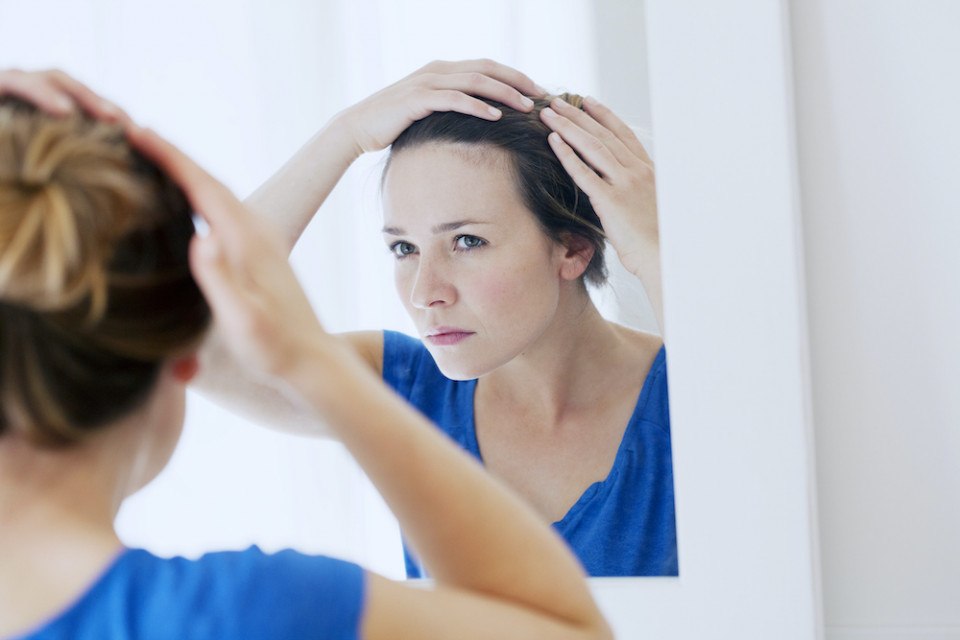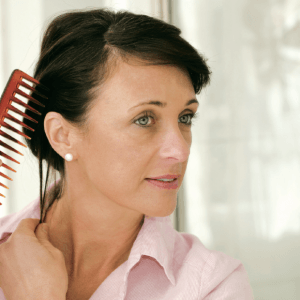Five Surprising Reasons Your Hair Is Thinning

/ Getty Images
If you’ve recently noticed a thinner ponytail, you’re not alone. Stress—including pandemic-related anxiety—can cause female hair loss, says Mary Wendel, M.D., Medical Director of Medi Tresse.
But while increased stress can increase shedding, it’s only one of more than five common causes of alopecia. That’s why seeking specialist help is crucial for counteracting hair loss.
“It takes a skilled and highly trained medical professional to do a thorough exam, order the proper tests, and make the correct diagnosis,” Dr. Wendel says. “Just picking up a bottle of minoxidil or a special shampoo at the pharmacy is not the answer.”
Read up on five of the most common causes of female hair loss below, then reach out to a pro to get the treatment plan that’s right for you.
Stress
Surplus stress doesn’t just cause sleep loss, headaches, and anxiety. Its extensive effects can also include a type of hair loss called telogen effluvium. “While it is normal to shed between 50 and 100 hairs a day, during a telogen effluvium episode you can notice more excessive shedding,” Dr. Wendel says. Shedding normally occurs during the telogen, or resting, phase of the hair cycle. However, during a telogen effluvium event either an abnormal number of hairs enter this phase or the telogen phase is extended. Approximately two months after the causative event, excess shedding all over the scalp begins and may last up to six months.
The Solution: While reducing stress through lifestyle choices—like meditation or exercise— can help get your body back on track, additional treatments like low-level laser therapy (LLLT), vitamins and supplements, and topical products can restore hair sooner, Dr. Wendel says.
Tight Hairstyles
Sleek ponytails, braids, cornrows, and extensions can pull hair tightly, putting stress and tension on the follicle. Over time, the damage can stop the follicle from producing hair altogether in what’s called traction alopecia. This type of hair loss most often appears on the temples, on the front of the hairline, or between brains or cornrows. Choosing tight styles occasionally is fine, but switch it up if one has become your go-to. “Traction alopecia does not occur overnight and it does not mean you can never utilize hairstyles that put tension on your hair,” Dr. Wendel says. “However, if you want to prevent traction alopecia from occurring, it is best to avoid these types of hairstyles every day or for a prolonged period of time.”
The Solution: In addition to wearing looser styles, patients with traction alopecia can seek out optimal platelet concentration therapy, platelet rich plasma therapy (PRP), LLLT, vitamins and supplements, and/or topical products to counteract hair loss.
Diet
Missing hairs can sometimes trace back to what’s missing from your plate. “One of the most common causes of hair shedding in women is iron deficiency,” Dr. Wendel says. Crash diets in particular can aggravate hair loss. In addition to causing nutrient deficiencies, restrictive weight-loss plans put a lot of stress on the body, including the follicles.
The keto diet, for example, is often linked with telogen effluvium. “Many people on the keto diet are so focused on getting to ketosis that they focus more on fats and are not getting enough protein,” Dr. Wendel says. “Protein is a key building block for hair, so if your diet is protein-deficient, it will negatively affect your hair.”
The Solution: Seeking out tests at a specialist can help pinpoint what’s going on. If you’re trying to lose weight, plan to do so safely and gradually. Fill your diet with sources of biotin, copper, iron, zinc, vitamin A, vitamin C, and vitamin E to prevent hair breakage and thinning. In addition to vitamins and supplements, LLLT and topical products can help restore lost hair.
Genetics
Just like eye color or freckles, hair loss is an inheritable trait—not only in men, but in women too. “The most common type of hair loss is androgenic alopecia, or female pattern hair loss (FPHL),” says Dr. Wendel. “Female pattern hair loss tends to run in families, and inheritance can be from either the mother or father, but sometimes there is no obvious family history.”
Unlike male pattern baldness, the female version often presents as a widening part and thinning throughout the top of the head. Hormone changes—like those associated with birth control pills, pregnancy, and menopause—can aggravate FPHL as well. It’s more common as women age, but it can start as early as the teenage years. In fact, up to 50% of women experience some degree of female pattern hair loss in their lifetime.
The Solution: To counteract FPHL, several treatment options like optimal platelet concentration therapy, PRP therapy, LLLT, vitamins and supplements, and topical products exist.
Illness
Alopecia areata, an autoimmune disease, can induce inflammation around the follicles and stop hair from growing. The condition may even cause eyebrows and eyelashes to disappear. While this particular condition is fairly rare, really any serious illness can result in hair loss. The stress on your body can cause a telogen effluvium event. No matter what, seeking medical guidance in the event of hair loss is key since it may point to an underlying condition.
“It is incredibly important to be properly evaluated and obtain the correct diagnosis before starting any hair loss treatment,” Dr. Wendel says. “Even mild alterations in thyroid function will result in poor hair growth, so it is essential to check that as well.”
The Solution: For alopecia areata, Dr. Wendel recommends topical treatments. Recent research has also shown that optimal platelet concentration therapy and PRP therapy, may be effective for some patients. For telogen effluvium, LLLT and vitamins and supplements tend to work best.
Get the expert help you deserve at Medi Tresse, a female hair rejuvenation clinic with locations in Wellesley and Worcester.
This is a paid partnership between Medi Tresse and Boston Magazine


